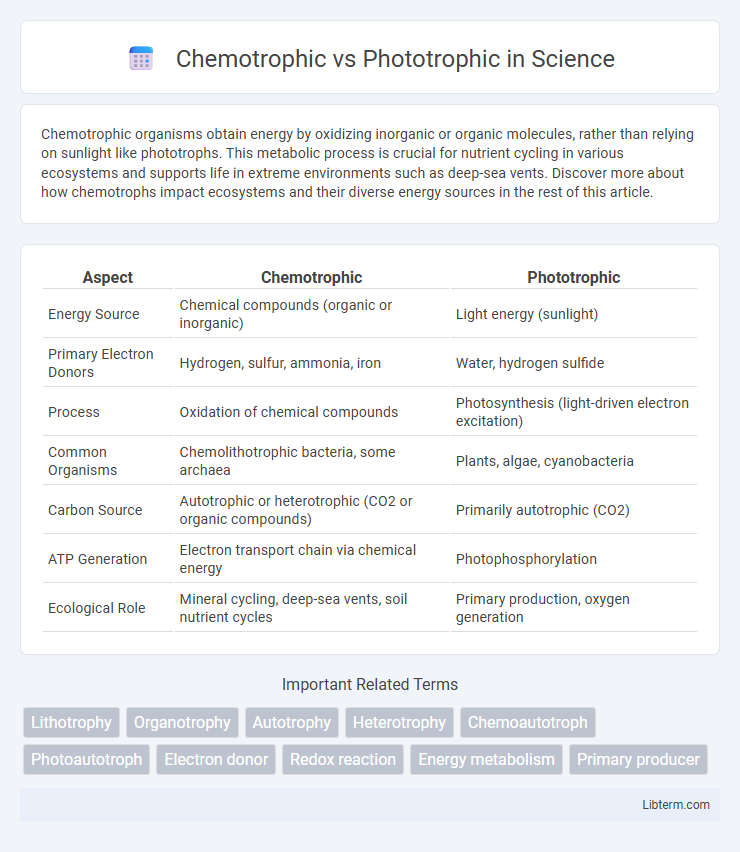Chemotrophic organisms obtain energy by oxidizing inorganic or organic molecules, rather than relying on sunlight like phototrophs. This metabolic process is crucial for nutrient cycling in various ecosystems and supports life in extreme environments such as deep-sea vents. Discover more about how chemotrophs impact ecosystems and their diverse energy sources in the rest of this article.
Table of Comparison
| Aspect | Chemotrophic | Phototrophic |
|---|---|---|
| Energy Source | Chemical compounds (organic or inorganic) | Light energy (sunlight) |
| Primary Electron Donors | Hydrogen, sulfur, ammonia, iron | Water, hydrogen sulfide |
| Process | Oxidation of chemical compounds | Photosynthesis (light-driven electron excitation) |
| Common Organisms | Chemolithotrophic bacteria, some archaea | Plants, algae, cyanobacteria |
| Carbon Source | Autotrophic or heterotrophic (CO2 or organic compounds) | Primarily autotrophic (CO2) |
| ATP Generation | Electron transport chain via chemical energy | Photophosphorylation |
| Ecological Role | Mineral cycling, deep-sea vents, soil nutrient cycles | Primary production, oxygen generation |
Introduction to Chemotrophic and Phototrophic Organisms
Chemotrophic organisms obtain energy by oxidizing chemical compounds, often inorganic substances like hydrogen sulfide or ammonia, to drive metabolic processes. Phototrophic organisms harness light energy through photosynthesis, converting sunlight into chemical energy stored in organic molecules. Both types of organisms play crucial roles in ecosystems, contributing to energy flow and nutrient cycling by utilizing distinct energy sources.
Defining Chemotrophy: Energy from Chemical Compounds
Chemotrophy is the metabolic process by which organisms obtain energy through the oxidation of chemical compounds, often inorganic substances such as hydrogen sulfide, ammonia, or ferrous iron. Unlike phototrophic organisms that harness energy from sunlight via photosynthesis, chemotrophs rely on redox reactions involving chemical substrates to generate ATP. This energy acquisition strategy is common among certain bacteria and archaea, especially those inhabiting extreme environments like deep-sea hydrothermal vents or sulfur-rich hot springs.
Phototrophy Explained: Harnessing Light for Energy
Phototrophy harnesses light energy through specialized pigments like chlorophyll to drive photosynthesis, converting solar energy into chemical energy stored as glucose. Organisms such as plants, algae, and cyanobacteria utilize phototrophic mechanisms to produce oxygen and sustain ecosystems by forming the base of food webs. This process contrasts with chemotrophy, which derives energy from chemical compounds, highlighting phototrophy's vital role in carbon fixation and energy flow in the biosphere.
Key Differences Between Chemotrophs and Phototrophs
Chemotrophs obtain energy through the oxidation of inorganic or organic compounds, whereas phototrophs harness light energy via photosynthesis. Chemotrophs are commonly found in environments lacking sunlight, such as deep-sea vents, while phototrophs typically thrive in light-rich habitats like surface waters and terrestrial ecosystems. The primary distinction lies in energy acquisition: chemotrophs rely on chemical reactions, and phototrophs depend on light-driven processes to synthesize organic molecules.
Metabolic Pathways in Chemotrophs
Chemotrophic organisms derive energy through the oxidation of inorganic or organic molecules, utilizing electron transport chains that facilitate ATP synthesis via oxidative phosphorylation. These metabolic pathways include aerobic respiration, anaerobic respiration, and fermentation, each adapted to specific terminal electron acceptors such as oxygen, nitrate, or sulfate. Enzymes like dehydrogenases and reductases play critical roles in transferring electrons from substrates to electron carriers, enabling energy conservation independent of light.
Types of Phototrophic Organisms
Phototrophic organisms are primarily classified into oxygenic and anoxygenic types based on their photosynthetic processes and the presence or absence of oxygen production. Oxygenic phototrophs, such as cyanobacteria, algae, and plants, utilize water as an electron donor and release oxygen during photosynthesis, while anoxygenic phototrophs, including purple sulfur bacteria and green sulfur bacteria, use electron donors like hydrogen sulfide and do not produce oxygen. These organisms play critical roles in ecosystems by converting light energy into chemical energy and supporting the base of food webs.
Ecological Roles of Chemotrophs and Phototrophs
Chemotrophs contribute to ecological nutrient cycling by oxidizing inorganic or organic compounds, supporting ecosystems such as deep-sea hydrothermal vents and sulfur-rich springs where sunlight is absent. Phototrophs drive primary production in most ecosystems through photosynthesis, converting solar energy into chemical energy and forming the base of food webs in terrestrial and aquatic environments. Together, chemotrophs and phototrophs sustain biodiversity by enabling energy flow and biogeochemical cycling in diverse habitats with varying light and chemical availability.
Examples of Chemotrophic and Phototrophic Species
Chemotrophic species include Nitrosomonas, which oxidizes ammonia to nitrite, and Sulfolobus, known for sulfur oxidation in acidic environments. Phototrophic species feature plants like Arabidopsis thaliana and cyanobacteria such as Synechocystis, which perform oxygenic photosynthesis using light energy. These organisms illustrate diverse energy acquisition strategies critical for ecological nutrient cycles and energy flow.
Applications in Biotechnology and Industry
Chemotrophic organisms, which obtain energy through chemical compounds, are extensively used in bioremediation to degrade pollutants and in bioleaching for metal extraction from ores. Phototrophic organisms, such as algae and cyanobacteria, play a vital role in sustainable biofuel production and carbon capture technologies due to their ability to convert solar energy into biomass. Both chemotrophic and phototrophic microbes are exploited for producing valuable biochemicals, enzymes, and pharmaceuticals, making them integral to various biotechnological and industrial applications.
Evolutionary Significance and Adaptations
Chemotrophic organisms derive energy from chemical compounds, enabling survival in environments devoid of sunlight, which highlights an early evolutionary strategy for life on Earth. Phototrophic organisms capture light energy via photosynthesis, driving oxygen production and shaping Earth's atmosphere, marking a pivotal evolutionary advancement. Adaptations include specialized enzymes for chemical oxidation in chemotrophs and optimized chlorophyll pigments in phototrophs, reflecting distinct ecological niches and evolutionary pressures.
Chemotrophic Infographic

 libterm.com
libterm.com